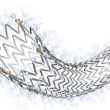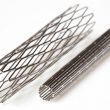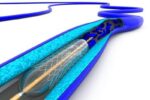The ICTUS (Invasive Versus Conservative Treatment in Unstable Coronary Syndromes) trial compared early invasive strategy with a selective invasive strategy in patients with non-ST-segment elevation acute coronary syndrome (NSTE-ACS), with elevated markers such as cardiac troponin T. The absence of long-term benefit of an early invasive strategy at 1 and 5 years had already been reported.<a href="https://solaci.org/en/2017/05/09/follow-up-at-10-years-for-invasive-vs-conservative-strategy-for-non-st-segment-elevation-infarction/" title="Read more" >...</a>
New Generation of DES already being tested, so far safe
This study evaluated the safety and efficacy of the new drug eluting stents (Medtronic, Santa Rosa, California) to treat de novo coronary lesions. These new polymer free drug filled stents have the potential to improve clinical outcomes and allow a shorter dual antiplatelet therapy. In addition, they have been made with three layers of continuous<a href="https://solaci.org/en/2017/02/21/new-generation-of-des-already-being-tested-so-far-safe/" title="Read more" >...</a>
Stroke Predictors in TAVR: CoreValve vs. Sapien
A comprehensive analyzis of cerebrovascular events in major randomized controlled studies on transcatheter aortic valve replacement (TAVR) has shown some interesting data on both risks and timing of stroke in this setting. The study carried out by Dr. Neal Kleiman, reviewed data on stroke and stroke predictors among 3,687 patients included in the CoreValve<a href="https://solaci.org/en/2016/09/21/stroke-predictors-in-tavr-corevalve-vs-sapien/" title="Read more" >...</a>
Patients with Plaque Erosion: Management without Stenting
This small study presented at ESC and simultaneously published in the European Heart Journal evaluated patients undergoing acute coronary syndrome caused by plaque erosion identified by optical computed tomography (OCT). The study showed it can be managed with conservative antithrombotic therapy and without stenting. Patients with plaque erosion can receive dual antiplatelet therapy, ticagrelor and aspirin<a href="https://solaci.org/en/2016/09/07/patients-with-plaque-erosion-management-without-stenting/" title="Read more" >...</a>
Polymer Free Drug Coated Stent in High Bleeding Risk Patients with Only One Month DAPT
Original Title: Polymer-free Drug-Coated Coronary Stents in Patients at High Bleeding Risk Reference: Philip Urban et al. N Engl J Med. 2015 Oct 14. [Epub ahead of print]. High bleeding risk patients undergoing PCI usually receive conventional bare metal stents (BMS) to allow the shortest possible DAPT (dual antiplatelet therapy), usually a month long. This<a href="https://solaci.org/en/2015/11/16/polymer-free-drug-coated-stent-in-high-bleeding-risk-patients-with-only-one-month-dapt/" title="Read more" >...</a>
RESPECT: Randomized clinical trial evaluated the patent foramen oval closure vs clinical treatment in patients with cryptogenic stroke
Fundamentals: Etiology of cryptogenic stroke stills a major challenge for medicine. Paradoxical embolism remains one of the possible causes. Undoubtedly, adults between 20 and 54 years represent a significant proportion of this population, and this is associated with a high morbidity and high costs not only in relation to the pathology itself but also to<a href="https://solaci.org/en/2015/06/24/congress-item-7070/" title="Read more" >...</a>
ISAR-LEFT MAIN 2: Everolimus-eluting stents versus Zotarolimus eluting stents in the treatment of the unprotected left coronary trunk.
Summary: Second-generation drug-eluting stents have shown better results than their predecessors. In this study we compare two second-generation drug stents in patients with unprotected left coronary trunk injuries. Methods and results: 650 patients with unprotected trunk injury were randomized to either XIENCE V (everolimus eluting) or RESOLUTE (zotarolimus eluting) stents. The primary endpoint was the<a href="https://solaci.org/en/2015/06/24/congress-item-7021/" title="Read more" >...</a>
Artic Study: Bedside Platelet Function Monitoring to Reduce Events after DES Implantation .
Given the individual variability of response to antiplatelet therapies, measuring platelet function and designing tailored therapies could be beneficial. The ARTIC study tested the superiority of bedside platelet function monitoring with drug adjustment vs. the conventional post DES therapy without monitoring and drug adjustment. It included 2466 patients with stable coronary disease or Non-ST Elevation<a href="https://solaci.org/en/2015/06/24/congress-item-6874/" title="Read more" >...</a>
RIBS V: Pharmacological balloon vs second-generation drug-eluting stent in the treatment of BMS restenosis
The ideal therapy for treating in-stent restenosis continues to be debated . The pharmacological balloons showed good results in this context, but no direct comparisons available of pharmacological balloonsversus second-generation DES.This prospective, multicenter randomized 189 patients with in-stent restenosis of conventional stents receiving pharmacological balloon or everolimusDES.The primary endpoint was angiographicat 9 months spotting a<a href="https://solaci.org/en/2015/06/24/congress-item-6300/" title="Read more" >...</a>
Everolimus eluting stent in total occlusions
Original title: Safety and Effectiveness of Everolimus-Eluting Stents in Chronic Total Coronary Occlusion Revascularization Results From the EXPERT CTO (Evaluation of the XIENCE Coronary Stent, Performance, and Technique in Chronic Total Occlusions) Multicenter Trial. Reference: David E. Kandzari et al. J Am Coll Cardiol Intv. 2015, on line before print. The aim of this study was to evaluate<a href="https://solaci.org/en/2015/04/30/n-5181/" title="Read more" >...</a>









